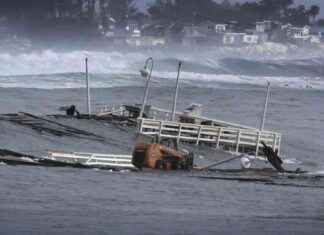Tangled in a pile of webbing and his bulletproof vest, Caleb Weiss slides the helicopter door open and sits down on the edge. Beneath his feet, as far as the eye can see, a compact, impenetrable forest. Tension rises in the cabin: we are within gunshot range of the Allied Democratic Forces (ADF) rebels.
The device skims the canopy, describes circles above the Ituri and Semuliki rivers, where these fighters, who pledged allegiance to the Islamic State organization in 2019, set up their camps. For almost an hour, Caleb Weiss, an American covered in tattoos who works for the American organization Bridgeway Foundation, threw out thousands of leaflets calling on the rebels to surrender.
From the forests of the northeast of the Democratic Republic of Congo (DRC) – part of which is located in Virunga Park – the ADF has for around ten years launched deadly raids on villages and roads on the borders of the provinces of North Kivu and Ituri to pillage and terrorize the population.
” Go home “
These several hundred militiamen, according to the United Nations, are responsible for the deaths of thousands of civilians, most often killed in an extremely brutal manner. They operate in Congolese territory and, to a lesser extent, in Uganda, where most of the group’s leaders come from.
The Islamic State (IS) group, which considers them its “province in Central Africa” (Iscap, English acronym), has claimed around a hundred attacks since the start of the year. The number of these demands is clearly increasing, but below what has been recorded by the Congolese security forces and civil society actors in the region. In April alone, more than a hundred people were killed and dozens kidnapped.
Since the end of 2021, the Ugandan army has deployed thousands of soldiers in the area. They are supposed to collaborate with the Armed Forces of the DRC (FARDC) in neutralizing the ADF, within a joint operation called “Shujaa” (“the brave”, in Swahili).
But, according to several security sources interviewed by AFP, the level of trust between the two armies is close to zero. The Ugandans carry out operations and set up bases without warning their hosts. This has led on several occasions, according to the same sources, to the loss of soldiers and injuries on the FARDC side.
Prices on heads
On the small colored cardboard boxes scattered by Mr. Weiss from the sky in the territories of Beni, Irumu and Mambasa, smiling portraits of former members of the ADF “deradicalized” and reintegrated into civilian life are printed on the front. On the back, a map of the region indicates meeting points for those who would like to escape to “return home” and promises them “state assistance”.
These costly air operations were launched in early April by the Texas-based Bridgeway Foundation, which says it works to “eliminate and prevent mass atrocities around the world.” It is the “philanthropic” arm of an investment fund, Bridgeway Capital Management, which gives it part of its profits to carry out its actions.
One of the boxes is different from the others and the Bridgeway Foundation does not want it photographed, “otherwise people will think we work for the American government,” says Mr. Weiss.
On it are printed the star-spangled banner, a telephone number and a promise of 5 million dollars (4.6 million euros) “for any information on the leader of the ADF-MTM/ISIS-DRC Seka Musa Baluku”, attached to two portraits.
Since the inclusion in 2021 of the ADF on the list of organizations affiliated with ISIS by the United States, a price has been put on his head. Bridgeway Foundation engaged in tracking him and other leaders of the group, hand in hand with Ugandan and Congolese military intelligence.
Child abduction
In the operating room of the Béni hospital, a radio plays Congolese rumba at a low volume. The injured follow one another under the instruments of the surgical team of the International Committee of the Red Cross (ICRC) and the Congolese Ministry of Health.
In a nearby room, a 13-year-old boy lies in bed, his chest and abdomen covered in bandages. All around him, men, also injured, most of them victims of recent ADF attacks. The AFP team visiting the hospital in early May was not authorized to speak with the young patient: he is “an ADF fighter”, explains the medical team, who seem to fear that the Rebels come one day to recover it by force.
In a video shot a few days earlier, the same boy, lying on the ground, with a bloody bandage on his right side, is questioned by Congolese soldiers who film him with their cell phones. He struggles to breathe, seems unable to move.
He recounts his kidnapping from a village dozens of kilometers further south, then “military training” and indoctrination by ADF leaders. “And the little one who died, do you know him? », asks one of the soldiers, referring to a young “combatant” killed during the same operation. “No, we ended up together, but I don’t know him,” the injured boy replies in a thin voice. “We were heading towards the [ADF] camp when we passed you, and you shot at us. »






